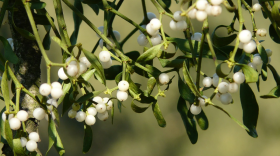TALLAHASSEE --- The amount of land in Florida dedicated to growing citrus continues to shrink.
Reports issued last week by the U.S. Department of Agriculture said Florida had 17 percent fewer acres used for growing oranges, grapefruit and other citrus than in 2023, though the harvest during the 2023-2024 growing season was valued 6 percent higher than the previous season.
A preliminary federal Commercial Citrus Inventory report found 274,705 acres in Florida continued to be used for citrus production, down from 332,256 acres when the annual survey was conducted in 2023.
Hendry County was down 12,374 acres, the largest acreage loss over the past year. Polk County, which has more commercial acres than any other county, saw a drop from 60,131 acres to 58,516 acres.
Citrus land has been dwindling for more than two decades as the industry has faced pressure from residential and commercial growth, increased foreign competition, hurricane damage in 2004, 2005, 2017 and 2022, and the effects of citrus greening disease, which has decimated groves.
Matt Joyner, CEO of Florida Citrus Mutual, said the industry remains “unbelievably viable,” growers are excited about current “tree health,” and Florida continues to have more acres in citrus production than any other state.
“A lot of these acres that we're seeing lost are not lost for good,” Joyner said. “I think you'll see a lot of that come back into production as growers look to replant. But right now, they're taking care of what they've got, and they're making sure that they can get these groves back to peak production from the multiple storm impacts.”
Hurricane Ian, which made landfall in September 2022 in Southwest Florida before crossing the state, caused massive damage in prime citrus-growing areas.
Growers in the early stages of the 2024-2025 season might not see much of an increase in the overall harvest from the prior seasons.
“My guess is that we may be somewhere net flat in terms of overall boxes (of citrus),” Joyner said. “I think what we'll see is better production per acre.”
Some citrus owners have sold land or used it for other purposes.

For example, Alico, Inc., a major Fort Myers-based citrus grower, said in a quarterly report in May that while it planned to conduct citrus operations “for years to come,” it was selling 780 acres of “underperforming” groves for $7 million.
The deal included an option for an additional 680 acres at the same $9,000-per-acre price.
“This new transaction … illustrates our strategy of monetizing underperforming citrus groves on a case by case basis to redeploy capital to generate better returns for our shareholders,” Alico said in the report.
The company also projected that it might take “another season, or more” for its groves to fully return to pre-Hurricane Ian levels.
Even with the reduced amount of land for groves, orange production accounted for about 9 percent of Florida agriculture cash receipts, trailing plants for gardens, greenhouses, nurseries and landscaping at 14.4 percent and sugarcane at 9.7 percent, according to the most recent figures from the U.S. Department of Agriculture's Economic Research Service.
Joyner said the industry can again be “the powerhouse that it has always been.”
“Quite honestly, I think as a single commodity in the state. we're probably still No. 1, No. 2, No. 3, somewhere in the top,” Joyner said. “We were so big for so long that sometimes we lose perspective as to just what this commodity, citrus, is in the state of Florida right now.”
A decade ago, the state had 515,147 acres in citrus, with oranges accounting for 452,364 acres.
In 2004, there were 748,555 acres used for citrus, with orange groves making up 622,821 acres. At that time, the industry produced 242 million 90-pound boxes of oranges, 40.9 million boxes of grapefruit and 8.9 million boxes of specialty fruits, which are primary tangerines and tangelos.
The 2003-2004 on-tree value of citrus in Florida was $746 million.
The on-tree value for the 2023-2024 season was $221 million, up from $208 million during the storm-wracked 2022-2023 season, according to a federal report on production, price and value released Thursday.
The industry closed out the 2023-2024 season in July with 17.96 million boxes of oranges harvested. That was up from the 15.82 million boxes produced during the 2022-2023 season, which was the lowest orange total since the 1934-1935 season.
Grapefruit production ended the 2023-2024 season at 1.79 million boxes, which was lower than the 1.81 million boxes produced in 2022-2023. The two seasons marked the first time Florida’s grapefruit production was under 2 million boxes in 110 years.
Specialty crops ended the 2023-2024 season at 450,000 boxes, the lowest since the category was first listed separately following the 1919-1920 season.







